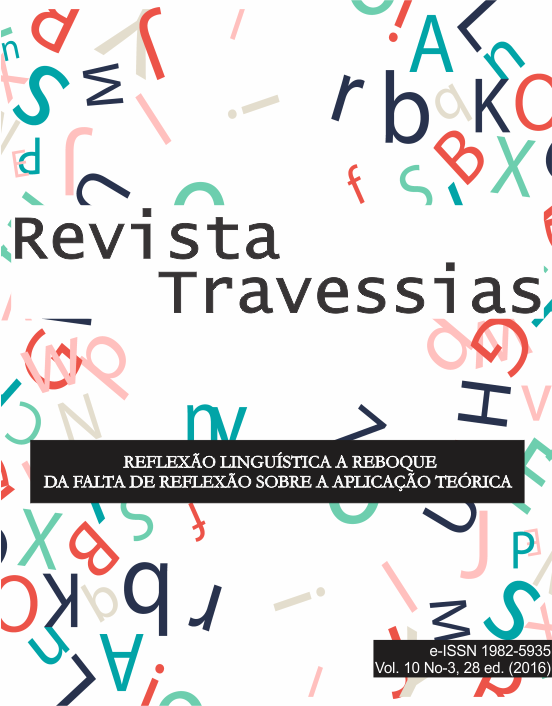As propriedades discursivas da quadra popular
Palavras-chave:
Gênero Discursivo, Quadra Popular, Enunciado Concreto.Resumo
O tema central desta pesquisa é o estudo do gênero, mais especificamente, delimita-se ao estudo dos aspectos discursivos que caracterizam a quadra popular. De modo geral, busca refletir sobre o gênero quadra popular a fim de compreender, essencialmente, como ela se caracteriza discursivamente. Especificamente, verifica-se como se caracteriza a quadra popular “Batatinha, quando nasce”, observando aspectos relativos à instabilidade estilística da forma que compõe o gênero assim como aspectos temáticos, enunciativos e composicionais. Metodologicamente, trata-se de uma pesquisa bibliográfica que descreve qualitativamente o corpus determinado. Nessas condições, este artigo apresenta os conceitos de gênero do discurso e a função dialógica da linguagem segundo os pressupostos teóricos de Bakhtin e seu Círculo. Conclui-se, portanto, que a quadra popular, em vista da intencionalidade comunicativa do enunciador, das situações de enunciação, dos tons avaliativos e dos significados temáticos que a revestem discursivo e estilisticamente se caracteriza como mais uma das modalidades de gênero do discurso.
Downloads
Referências
BAKHTIN, M. M. Estética da criação verbal. Tradução de Paulo Bezerra. 6. ed. São Paulo: Martins Fontes, 2011.
______. Marxismo e Filosofia da Linguagem: problemas fundamentais do método sociológico na ciência da linguagem. Trad. Michel Lahud e Yara Frateschi Vieira. 12. ed. São Paulo: Hucitec, 2002.
______. VOLOSHÍNOV, V. N. [1926]. Discurso na vida e discurso na arte (sobre poética sociológica). Trad. de Carlos Alberto Faraco e Cristóvão Tezza. (mimeo).
FARACO, C. A. Linguagem & Diálogo: as ideias linguísticas do círculo de Bakhtin. São Paulo: Parábola, 2009.
FREUD, S. O Mal-Estar na Civilização. Trad. José Octávio de Aguiar Abreu. Rio de Janeiro: Imago, 1997.
HANSEN, J. A. Alegoria: construção e interpretação da metáfora. 1. ed. São Paulo: Atual, 1986.
MACHADO, Irene. Os gêneros do discurso. In: BRAIT, B. (Org.). Bakhtin: conceitos-chave. 5. ed. São Paulo: Contexto, 2012. cap. 8. p. 151-166.
MIOTELLO, V. Ideologia. In: BRAIT, B. (Org.). Bakhtin: conceitos-chave. 5. ed. São Paulo: Contexto, 2012. cap. 9. p. 167-176.
OLIVEIRA, M. B. F. Contribuições do círculo de Bakhtin ao ensino da língua materna. Revista do Gelne. Natal, v. 4, n. 1, p. 1 a 5, 2002. Disponível em: <http://www.gelne.org.br>. Acesso em: 25 out. 2014.
PONTES, E. Metáfora. 2. ed. Campinas: Editora da Unicamp, 1990.
WANKE, E. T. A Trova. A trova popular. Rio de Janeiro: Pongetti, 1974.
Downloads
Publicado
Como Citar
Edição
Seção
Licença
Aviso de Direito Autoral Creative Commons
Política para Periódicos de Acesso Livre
Autores que publicam nesta revista concordam com os seguintes termos:
1. Autores mantêm os direitos autorais e concedem à revista o direito de primeira publicação, com o trabalho simultaneamente licenciado sob a Licença Creative Commons Attribution que permite o compartilhamento do trabalho com reconhecimento da autoria e publicação inicial nesta revista.
2. Autores têm autorização para assumir contratos adicionais separadamente, para distribuição não-exclusiva da versão do trabalho publicada nesta revista (ex.: publicar em repositório institucional ou como capítulo de livro), com reconhecimento de autoria e publicação inicial nesta revista.
3. Autores têm permissão e são estimulados a publicar e distribuir seu trabalho online (ex.: em repositórios institucionais ou na sua página pessoal) a qualquer ponto antes ou durante o processo editorial, já que isso pode gerar alterações produtivas, bem como aumentar o impacto e a citação do trabalho publicado (Veja O Efeito do Acesso Livre).
Licença Creative Commons
Esta obra está licenciada com uma Licença Creative Commons Atribuição-NãoComercial-CompartilhaIgual 4.0 Internacional, o que permite compartilhar, copiar, distribuir, exibir, reproduzir, a totalidade ou partes desde que não tenha objetivo comercial e sejam citados os autores e a fonte.



